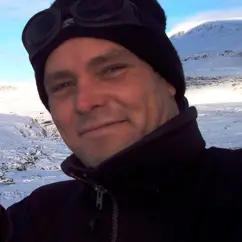Pelle Tejsner
Lektori

Paasissutissaq
| pete@uni.gl | |
| Telefonip normua | +299 34 73 32 |
| Immikkoortortaqarfik | Inuiaat Kulturiannut Oqaluttuarisaanerannullu Immikkoortortaq |
| Najugaq |
Ilimmarfik, Manutooq 1 Postboks 1061 3900 Nuuk |
Lektori
Kulturimik, Oqaatsinik Oqaluttuarisaanermillu Ilisimatusarfik
Inuiaat Kulturiannut Oqaluttuarisaanerannullu Immikkoortortaq
Allaffik: D249

My PhD was based on a year-long fieldwork on Disco Island / Northwest Greenland - and examined indigenous perceptions of climate change as part of my wider research around indigenous knowledge, socio-cultural resilience, sea-ice services, and socio-environmental relations among Arctic indigenous people
His postdoctoral research was sponsored by the Danish Independent Research Council and reviewed public discourses and civic engagement with a focus on indigenous people's rights in relation to non-renewable resource extraction (such as offshore oil, and mining) and the wider (potential) societal impacts with a view to promoting sustainable development of nonrenewable resource governance in Greenland and the wider Arctic (Canada and Alaska).
Sammisat
Alaska
Atasinnaasoq
Canada
Det antropocæne
Gassi
Ikke-fornybar resourceforvaltning
Inuk-uumasoq atassuteqaat
Kalaallit Nunaat
Mingutsitsineq
Nukissaqarniarnermut politikki
Nunat inoqqaavi (ilisimasat)
Nunat inoqqaavi (pisussaaneq)
Silap pissusia
Social-kulturel resiliens
Uulia
Aatsitassarsiorneq
Qupperneq ugguuna siammarteruk













 FACEBOOK
FACEBOOK LINKEDIN
LINKEDIN Assiliuk - linki
Assiliuk - linki
